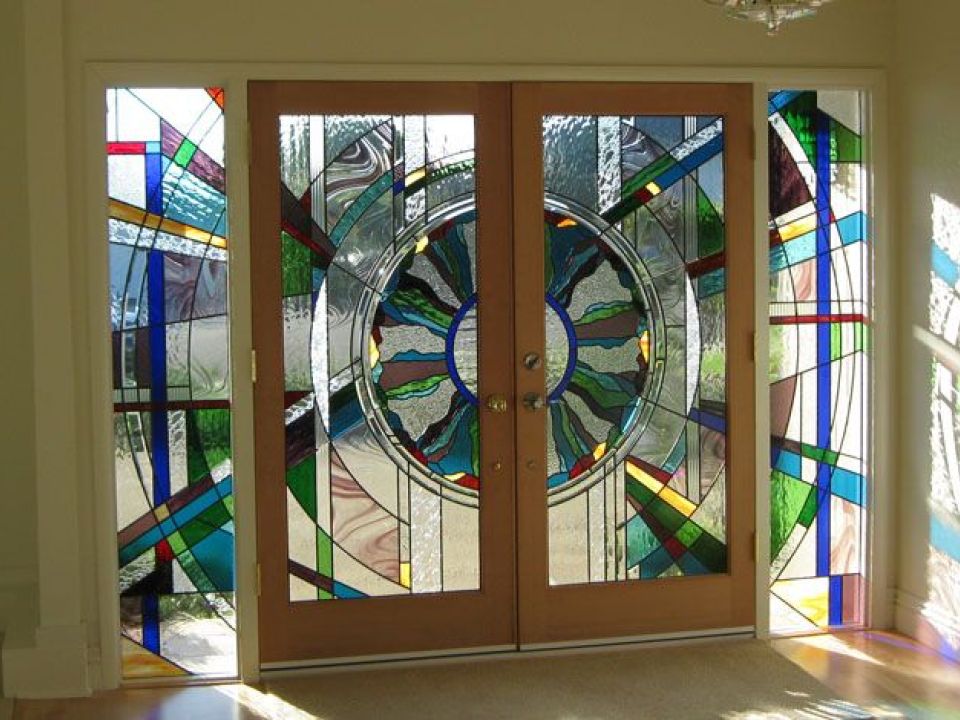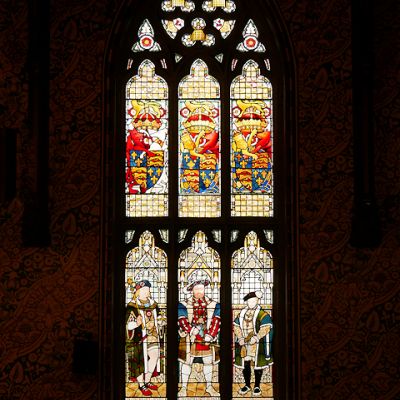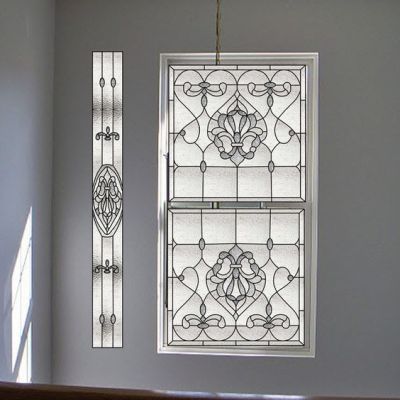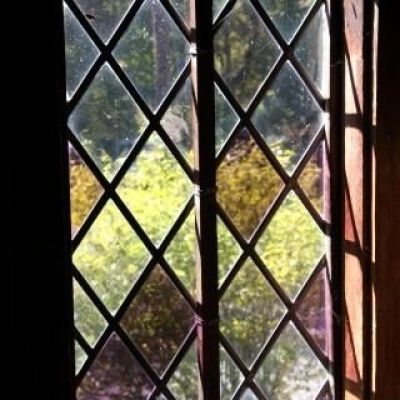From Tradition to Modernity: The Evolution of Stained Glass Doors in Architecture

Step through a grand entrance adorned with stained glass, and you're transported through time. Sunlight streams through, casting vibrant hues and intricate patterns on the floor, walls, and perhaps even yourself. These luminous portals aren't just beautiful entryways; they're living testaments to the enduring appeal and evolution of stained glass doors in architecture.
This blog post explores the fascinating journey of stained glass doors, tracing their roots back to ancient civilizations and delving into how they've transformed alongside architectural styles throughout history. We'll see how advancements in technique, changing artistic movements, and a constant desire for innovation have shaped the stained glass doors we encounter today.
Ancient Beginnings: Stained Glass Takes Root
The origins of stained glass can be traced back further than you might think. While the elaborate window displays found in European cathedrals are often what come to mind, evidence suggests the use of colored glass for decorative purposes dates back to ancient Egypt and Mesopotamia. Small colored glass pieces were used in mosaics and decorative objects, laying the groundwork for the development of stained glass techniques.
Early Developments:
-
Roman Empire: The Roman Empire used colored glass for decorative purposes, primarily in windows. However, these were not true stained glass panels as we know them today, but rather pieces of colored glass arranged in a lattice framework.
-
Byzantine Empire: The Byzantine Empire played a crucial role in the development of stained glass techniques. They pioneered the use of lead cames (thin strips of lead) to hold colored glass pieces together, a technique that would become the foundation for stained glass windows and doors.
Medieval Masterpieces: The Golden Age of Stained Glass Doors
The period from the 11th to the 16th centuries witnessed the golden age of stained glass in Europe. Grand cathedrals became canvases for magnificent stained glass windows, often depicting religious scenes and figures. Stained glass doors also flourished during this time, serving as both practical and artistic barriers for churches, monasteries, and castles.
Medieval Stained Glass Characteristics:
-
Religious Themes: The vast majority of stained glass doors from this period depicted religious figures, biblical stories, or heraldic emblems.
-
Bold Colors and Dramatic Scenes: Medieval stained glass was known for its use of bold colors, particularly blues, reds, and yellows. The scenes depicted were often dramatic and detailed, with a focus on storytelling.
-
Glassworking Techniques: Artisans honed their skills in glassmaking and developed techniques like glass painting and enameling to add detail and depth to their creations.
Examples:
-
Chartres Cathedral (France): The West Façade doors at Chartres Cathedral feature stunning stained glass panels depicting scenes from the life of Christ.
-
Canterbury Cathedral (England): The Christ Church Gate at Canterbury Cathedral boasts stained glass panels showcasing the martyrdom of St. Thomas Becket.
A Renaissance and Beyond: Shifting Styles and Techniques
The Renaissance ushered in a new era for stained glass, with a shift towards realism and perspective in the designs. Artists were increasingly inspired by classical themes and techniques.
Evolution in the Renaissance and Beyond:
-
Focus on Realism: Stained glass artists began incorporating techniques like chiaroscuro (shading) and perspective to create more realistic figures and scenes.
-
Classical Influences: Greek and Roman mythology became popular themes, alongside religious stories.
-
Technical Advancements: The invention of silver staining allowed for even greater detail and shading in the glass.
Examples:
-
Santa Maria del Fiore Cathedral (Italy): The Duomo in Florence boasts a series of stained glass windows by Renaissance masters like Donatello and Ghiberti, showcasing both religious and classical themes.
-
King's College Chapel (England): The magnificent east window at King's College Chapel exemplifies the intricate detail and realism achieved during the Renaissance.
From Victorian Elegance to Modern Innovation: A Kaleidoscope of Styles
The 19th century saw a surge in popularity of stained glass doors, particularly in homes. The Victorian era embraced romantic themes, with floral motifs, nature scenes, and literary references adorning stained glass doors. This period also saw advancements in glass manufacturing, leading to a wider range of colors and textures available to artists.
20th Century and Beyond: A Blend of Tradition and Innovation:
-
Art Deco: The rise of Art Deco brought geometric shapes, bold colors, and a sense of symmetry to stained glass designs.
-
Modern Movement: The 20th century saw a shift towards more abstract and minimalist designs in stained glass, often complementing modern architectural styles.
From Tradition to Modernity: A Kaleidoscope of Styles
Modern Stained Glass: Today, stained glass continues to evolve, embracing a kaleidoscope of styles and techniques. Here are some exciting trends in modern stained glass doors:
-
Abstract Designs: Modern stained glass often features abstract patterns and vibrant color palettes, adding a unique touch and a bold statement to entryways.
-
Fused Glass: This technique involves fusing multiple layers of glass together in a kiln, creating a textural and layered effect.
-
Digital Design and Fabrication: Modern technology allows for intricate designs and even incorporation of photographs or digital artwork within the stained glass.
-
Sustainability: Stained glass artists are increasingly using recycled glass or sustainable materials in their creations.
Examples:
-
Frank Lloyd Wright's Prairie Style Homes: Many of Frank Lloyd Wright's iconic Prairie Style homes feature stained glass doors with geometric patterns that complement the clean lines and natural materials of the architecture.
-
Modern Art Museums: Modern art museums often incorporate contemporary stained glass installations, showcasing the artistic possibilities of the medium.
A Legacy of Light and Beauty: The Enduring Appeal of Stained Glass Doors
So, why do stained glass doors continue to captivate us, even in our modern world? Here are some reasons for their enduring appeal:
-
Transformative Power of Light: Stained glass diffuses harsh sunlight and creates a warm, inviting glow, setting a specific mood and elevating the aesthetics of the entryway.
-
Artistic Expression: Stained glass doors are unique works of art, reflecting the artist's skills and creativity. They can become conversation pieces and add a touch of personality to your space.
-
Historical Connection: Stained glass doors can connect your home or building to a rich artistic heritage. They can be a reminder of the skill and artistry of past generations.
-
Versatility of Design: From traditional to modern, stained glass offers a wide range of design possibilities, allowing you to find a style that complements your architectural style and personal taste.
Conclusion
Stained glass doors are more than just beautiful architectural elements; they are a testament to the enduring human desire to transform light and color into art. From their ancient origins to the innovative techniques employed today, stained glass doors have evolved alongside architecture, reflecting changing styles and artistic movements.
By understanding the rich history and diverse styles of stained glass doors, you can appreciate their enduring appeal and consider incorporating them into your own space. Whether you choose a traditional design echoing a bygone era or a modern masterpiece featuring abstract patterns, a stained glass door can become a luminous portal, transforming your entryway into a space bathed in beauty, history, and artistic expression. Embrace the legacy of light and color – let a modern stained glass door become a captivating welcome to your space.
FAQ's
Q: Are stained glass doors difficult to maintain?
A: Stained glass requires minimal maintenance. Regular dusting with a soft cloth and occasional cleaning with a gentle cleanser are typically sufficient. For valuable or antique stained glass doors, consult a professional for cleaning recommendations.
Q: Can stained glass doors be used in exterior applications?
A: While some stained glass can be used for exterior applications, it's crucial to choose materials specifically designed for outdoor use. These materials should be weather-resistant and able to withstand UV rays and temperature fluctuations. Consult with a stained glass artist or professional to discuss the suitability of exterior stained glass doors for your project.
Q: How much do modern stained glass doors cost?
A: The cost of a modern stained glass door can vary greatly depending on the size, complexity of the design, the artist's experience, and the materials used. Handcrafted stained glass doors with intricate designs can be expensive, while prefabricated panels or simpler designs offer a more budget-friendly option.
Looking to enhance your period home with bespoke craftsmanship? At Old English Doors, we specialise in creating custom wooden doors, windows, porches, and more - designed to reflect your home’s unique charm. Contact us today for a personalised quote and bring timeless elegance to your property.


